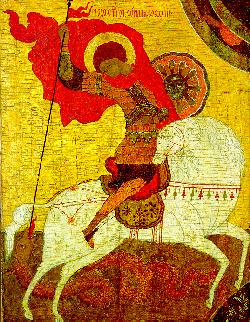
Novgorod School. Early 15th century.
Tretiakov Gallery, Moscow, 82 x 63 cm.
 The cult of the great martyr St. George (megalomartyros) originated in the fifth century in Cappadocia. The saint was probably martyred at Lydda (Diospolis) at the end of the third or the beginning of the fourth century. According to the earliest versions of his vita, he was martyred by the Persian king Dadian, in later vitae transformed into the Emperor Diocletian. Around the eleventh century, a large number of legends was added to the description of the saint's martyrdom; most popular of those new legends was the story of George's encounter with the dragon, derived from the earlier oral tradition. In Russia, the cult spread widely during the reign of Yaroslav the Wise (the earliest representation, from the 12th century, is the fresco in the church of St. George in Staraia Ladoga).
The cult of the great martyr St. George (megalomartyros) originated in the fifth century in Cappadocia. The saint was probably martyred at Lydda (Diospolis) at the end of the third or the beginning of the fourth century. According to the earliest versions of his vita, he was martyred by the Persian king Dadian, in later vitae transformed into the Emperor Diocletian. Around the eleventh century, a large number of legends was added to the description of the saint's martyrdom; most popular of those new legends was the story of George's encounter with the dragon, derived from the earlier oral tradition. In Russia, the cult spread widely during the reign of Yaroslav the Wise (the earliest representation, from the 12th century, is the fresco in the church of St. George in Staraia Ladoga).
The icon from Novgorod presented here is one of the most famous Russian icons of St. George. Scholars marvel at its wonderful composition and the rhythm created by the horse's neck, the shield of the saint, and the halo. The movement begins with the saint's mount, and going through the outlines of the shield, the halo, and the flowing red mantle, it culminates in the powerful thrust of the lance. In the right upper corner of the composition we can see the hand of God extended from heaven to bless the saint on his miraculous deed and to indicate that St. George is just an instrument of God's will. Despite the Christian elements so clearly present in the icon, the shield of the saint is a symbol of the sun; this is possibly a reflection of the connection between St. George and the pagan sun-god Dazhbog. Since St. George's day (April 23) was the first day when the peasants took their flocks to the pasture and since Dazhbog's good will assured fertility of the fields and the general prosperity, the connection between the saint and the pagan god is quite understandable. Novgorod icons, particularly those created for less affluent patrons, often include such fascinating proofs of the so-called "dual faith" (dvoeverie).
In 1911, the owner of this icon, I. S. Ostroukhov, had it "professionally" restored. The restorer Baranov, as was customary at the time, made numerous "fill-ins" on the saint's cheeks and neck, completely removed the original gold background and the icon "hillocks" and instead of them painted the brownish layer of the earth, thus changing the composition of the icon and its overall impact according to his fancy. To rectify (at least partially) these distortions, I digitally removed the earth layer painted by the restorer Baranov from the icon. The image of the dragon is much better visible and the entire icon gains lightness and balance. For more information about icon restoration, see the Icon Restoration page. [A.B.]
